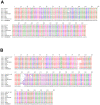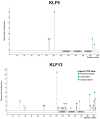Krüppel-like Factor-9 and Krüppel-like Factor-13: Highly Related, Multi-Functional, Transcriptional Repressors and Activators of Oncogenesis
- PMID: 38067370
- PMCID: PMC10705314
- DOI: 10.3390/cancers15235667
Krüppel-like Factor-9 and Krüppel-like Factor-13: Highly Related, Multi-Functional, Transcriptional Repressors and Activators of Oncogenesis
Abstract
Specificity Proteins/Krüppel-like Factors (SP/KLF family) are a conserved family of transcriptional regulators. These proteins share three highly conserved, contiguous zinc fingers in their carboxy-terminus, requisite for binding to cis elements in DNA. Each SP/KLF protein has unique primary sequence within its amino-terminal and carboxy-terminal regions, and it is these regions which interact with co-activators, co-repressors, and chromatin-modifying proteins to support the transcriptional activation and repression of target genes. Krüppel-like Factor 9 (KLF9) and Krüppel-like Factor 13 (KLF13) are two of the smallest members of the SP/KLF family, are paralogous, emerged early in metazoan evolution, and are highly conserved. Paradoxically, while most similar in primary sequence, KLF9 and KLF13 display many distinct roles in target cells. In this article, we summarize the work that has identified the roles of KLF9 (and to a lesser degree KLF13) in tumor suppression or promotion via unique effects on differentiation, pro- and anti-inflammatory pathways, oxidative stress, and tumor immune cell infiltration. We also highlight the great diversity of miRNAs, lncRNAs, and circular RNAs which provide mechanisms for the ubiquitous tumor-specific suppression of KLF9 mRNA and protein. Elucidation of KLF9 and KLF13 in cancer biology is likely to provide new inroads to the understanding of oncogenesis and its prevention and treatments.
Keywords: Krüppel-like factor 13 (KLF13); Krüppel-like factor 9 (KLF9); future directions; lncRNA; miR; oncogenesis; pathways.
Conflict of interest statement
The authors declare no conflict of interest. The funders had no role in the design of the study; in the collection, analyses, or interpretation of data; in the writing of the manuscript; or in the decision to publish the results.
Figures





Similar articles
-
Krüppel-Like Factors 9 and 13 Block Axon Growth by Transcriptional Repression of Key Components of the cAMP Signaling Pathway.Front Mol Neurosci. 2020 Nov 12;13:602638. doi: 10.3389/fnmol.2020.602638. eCollection 2020. Front Mol Neurosci. 2020. PMID: 33281552 Free PMC article.
-
The reproductive phenotype of mice null for transcription factor Krüppel-like factor 13 suggests compensatory function of family member Krüppel-like factor 9 in the peri-implantation uterus.Biol Reprod. 2012 Nov 16;87(5):115. doi: 10.1095/biolreprod.112.102251. Print 2012 Nov. Biol Reprod. 2012. PMID: 22993382 Free PMC article.
-
Molecular Mechanisms for Krüppel-Like Factor 13 Actions in Hippocampal Neurons.Mol Neurobiol. 2020 Sep;57(9):3785-3802. doi: 10.1007/s12035-020-01971-w. Epub 2020 Jun 23. Mol Neurobiol. 2020. PMID: 32578009
-
The kruppel-like factor (KLF) family, diseases, and physiological events.Gene. 2024 Feb 15;895:148027. doi: 10.1016/j.gene.2023.148027. Epub 2023 Nov 23. Gene. 2024. PMID: 38000704 Review.
-
Sp1 and krüppel-like factor family of transcription factors in cell growth regulation and cancer.J Cell Physiol. 2001 Aug;188(2):143-60. doi: 10.1002/jcp.1111. J Cell Physiol. 2001. PMID: 11424081 Review.
Cited by
-
Krüpple-like factors in cardiomyopathy: emerging player and therapeutic opportunities.Front Cardiovasc Med. 2024 Mar 7;11:1342173. doi: 10.3389/fcvm.2024.1342173. eCollection 2024. Front Cardiovasc Med. 2024. PMID: 38516000 Free PMC article. Review.
-
Integrative multiomics analysis reveals the subtypes and key mechanisms of platinum resistance in gastric cancer: identification of KLF9 as a promising therapeutic target.J Transl Med. 2025 Aug 7;23(1):877. doi: 10.1186/s12967-025-06725-7. J Transl Med. 2025. PMID: 40775648 Free PMC article.
-
KLF9 aggravates the cardiomyocyte hypertrophy in hypertrophic obstructive cardiomyopathy through the lncRNA UCA1/p27 axis.Int J Exp Pathol. 2025 Mar;106(2):e12526. doi: 10.1111/iep.12526. Int J Exp Pathol. 2025. PMID: 39909852
-
Transcriptomic Insights into Dual Temperature-Salinity Stress Response in "Shuike No. 1", a Pioneering Rainbow Trout Strain Bred in China.Biology (Basel). 2025 Jan 10;14(1):49. doi: 10.3390/biology14010049. Biology (Basel). 2025. PMID: 39857280 Free PMC article.
References
Publication types
Grants and funding
LinkOut - more resources
Full Text Sources

